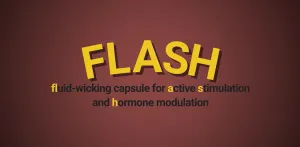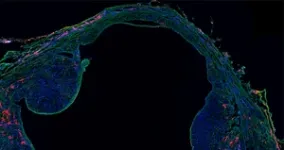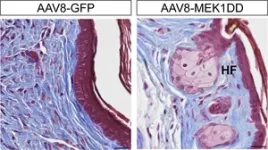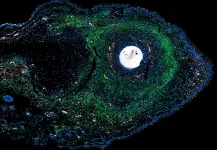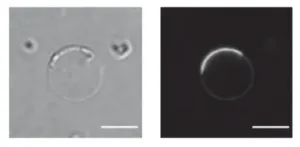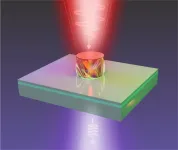(Press-News.org) The non-invasive FLASH system, inspired by lizard skin, electronically stimulates key hunger hormone
Nature is the greatest teacher. A bizarre-looking lizard with intimidating spikes covering its body helped a team of investigators from Brigham and Women’s Hospital, a founding member of the Mass General Brigham healthcare system, Massachusetts Institute of Technology, and New York University, develop an innovative ingestible capsule that can modify ghrelin, a hunger-regulating hormone, in pigs. Their results, published in Science Robotics, showed for the first time that the ingestible electronic fluid-wicking capsule for active stimulation and hormone modulation (FLASH) can be ingested to modulate gastrointestinal hormones through electrical stimulation of the stomach and safely excreted without side effects. The new system has potential applications for treating certain gastrointestinal, neuropsychiatric, and metabolic disorders.
“Our lab strives to develop systems that will make it easier and more accessible for patients to receive therapies,” said corresponding author Giovanni Traverso, MB, BChir, PhD, a gastroenterologist in the Brigham’s Division of Gastroenterology, Hepatology, and Endoscopy. “This is an exciting proof-of-concept study and a feat of fundamental research and engineering demonstrating the potential of ingestible electroceuticals.”
“An ingestible pill that contains electronics instead of chemicals or drugs is very promising,” said co-first author Khalil Ramadi, PhD, an assistant professor at New York University and a research affiliate at Brigham and Women’s Hospital. “It provides a way to deliver targeted electrical pulses to specific cells in the gut in a way that can regulate levels of neural hormones in the body.”
The team previously observed that patients with gastroparesis, a disorder that slows or stops the movement of food from the stomach to the small intestine, who received gastric pacemakers, which operate using electrical stimulation, seemed to feel better in a manner disproportionate to the improvements in motility. This led them to investigate if the electrical stimulation was inducing a neurohormonal effect. They found that electrical stimulation supported the production of ghrelin, a hormone associated with regulating hunger and eating. After an investigation of the underlying mechanisms of this, the team found that the response was mediated by the vagus nerve, the body’s longest autonomic nervous system nerve that connects the brain and gut.
To stimulate the release of this important hormone, the team set out to create an ingestible capsule, known as an electroceutical, that could emit electronic signals and would move through the body, eventually being excreted. Electroceuticals are devices that use electric signals to treat various conditions. Because there is fluid in the stomach that can interfere with an electroceutical system, the investigators looked to nature for ways to wick away fluid and allow the system to still have good contact with stomach tissue.
That’s where the Australian lizard Moloch horridus, or “thorny devil” comes in; its fluid-wicking skin allows it to better absorb water in the arid regions where it lives. The team mimicked this lizard skin feature in the creation of its surface-treated hydrophilic capsule design, and created grooves sized to promote fluid wicking while retaining the capacity to hold an electrode to support stimulation.
In this study, the team endoscopically stimulated the inner surface of pig stomachs for twenty minutes and found that ghrelin increased in those with intact vagus nerves. The point of contact between the capsule and the stomach tissue was analyzed via CT scans. The FLASH system, which folds up electronics and a battery source inside of the capsule, was shown to reproducibly increase levels of ghrelin in pigs.
The team plans to continue this research for translational human application and is looking at how the approach might work in other areas of the body. Next, they plan to investigate how FLASH and similar ingestible electroceuticals could be used to treat eating disorders and metabolic diseases.
“This development provides many new avenues for research into the complex interconnections between the brain and gut and for furthering the use of electroceuticals as a clinical intervention,” said co-first author James McRae, a PhD Candidate at the Massachusetts Institute of Technology’s Department of Mechanical Engineering.
“The potential to modulate hormones using ingestible electroceuticals is potentially transformative because it does not require new drugs,” said Traverso. “Instead, it works alongside our physiological systems for the benefit of the person.”
Disclosures: Khalil B. Ramadi, McRae, and Traverso are co-inventors on a patent application (No. 63/092,016) encompassing the work described.
Funding: This study was supported in part by a grant from Novo Nordisk, at the Massachusetts Institute of Technology (MIT) , the MIT Koch Institute’s Support (core) Grant from the National Cancer Institute, the National Institute for Diabetes and Digestive and Kidney Diseases, the Division of Engineering at New York University Abu Dhabi, a National Science Foundation graduate research fellowship and the Karl Van Tassel Career Development Professorship and the Department of Mechanical Engineering at MIT.
Paper cited: Ramadi, K. et al. “Bioinspired, fluid-wicking, ingestible electroceutical capsules for hunger-regulating hormone modulation.” Science Robotics, DOI: 10.1126/scirobotics.ade9676
END
Ingestible electroceutical capsule shows promise for treating gastrointestinal conditions
The non-invasive FLASH system, inspired by lizard skin, electronically stimulates key hunger hormone
2023-04-26
ELSE PRESS RELEASES FROM THIS DATE:
Ingestible “electroceutical” capsule stimulates hunger-regulating hormone
2023-04-26
CAMBRIDGE, MA -- Hormones released by the stomach, such as ghrelin, play a key role in stimulating appetite. These hormones are produced by endocrine cells that are part of the enteric nervous system, which controls hunger, nausea, and feelings of fullness.
MIT engineers have now shown that they can stimulate these endocrine cells to produce ghrelin, using an ingestible capsule that delivers an electrical current to the cells. This approach could prove useful for treating diseases that involve nausea or loss of appetite, such as cachexia (loss of body mass that can occur in patients with cancer or other chronic diseases).
In ...
Musical expertise makes older adults better listeners by keeping brain young
2023-04-26
The world’s population is aging at an unprecedented rate. Aging can lead to various types of cognitive decline, posing a serious burden to families and society. Therefore, it is crucial to develop effective interventions to promote healthy aging.
One promising approach is musical training, which is accessible to the majority of the population. Besides the musically rewarding and aesthetic experience of musical training, it also provides potential benefits to the brain, especially for the elderly.
In a study published as a cover story in Science Advances, a research team led by Dr. DU Yi from the Institute ...
ERK activity is a molecular switch between tissue regeneration and scarring
2023-04-26
Why do some animals regenerate lost tissues after injury while others don’t? Researchers from the lab of Kerstin Bartscherer (Osnabrück University and formerly Hubrecht Institute) and Ashley Seifert (University of Kentucky) studied spiny mice, which have a remarkable regenerative capacity, to answer this question. They compared and modulated the injury responses of these mice and common laboratory mice, that show scarring upon injury. This revealed that ERK signalling is a crucial molecular switch between scarring and regeneration. The results of this study will be published on April 26th in the scientific journal Science Advances and imply that ...
Decoding the mechanisms behind the assembly of BAR proteins that dictate cell curvature
2023-04-26
Ikoma, Japan – Cell membranes play a critical role by serving as containment units and separating the inner cellular space from the extracellular environment. Proteins with distinct functional units play a key role in facilitating protein-membrane interactions. For instance, “Bin-Amphiphysin-Rvs” (“BAR”) domain proteins are involved in regulating cell membrane curvature. This physical bending of cell membranes helps cells carry out various biologically important processes such as endocytosis and cell motility. Although BAR proteins drive membrane curvature ...
Children’s Hospital of Philadelphia, Princeton researchers identify novel genetic disorder
2023-04-26
Philadelphia, April 26, 2023 – Researchers from Children’s Hospital of Philadelphia (CHOP) and Princeton University have discovered a novel genetic disorder associated with neurodevelopmental differences. The discovery identified the disorder in 21 families from all over the world. The findings were published today in Science Advances.
The as-yet unnamed disorder is the result of a series of rare variants in the MAP4K4 gene, which is involved in many signaling pathways, including the RAS pathway ...
Almost one in three adults aged 45 and older who had both TB and COVID-19 died during a pandemic cohort study in NYC between March 2020 and June 2022
2023-04-26
Almost one in three adults aged 45 and older who had both TB and COVID-19 died during a pandemic cohort study in NYC between March 2020 and June 2022.
####
Article URL: https://journals.plos.org/globalpublichealth/article?id=10.1371/journal.pgph.0001758
Article Title: Cohort study of the mortality among patients in New York City with tuberculosis and COVID-19, March 2020 to June 2022
Author Countries: USA
Funding: The authors received no specific funding for this work. END ...
Nifty nanoparticles help ‘peel back the curtain’ into the world of super small things
2023-04-26
Physicists at The Australian National University (ANU) are using nanoparticles to develop new sources of light that will allow us to “peel back the curtain” into the world of extremely small objects – thousands of times smaller than a human hair – with major gains for medical and other technologies.
The findings, published in Science Advances, could have major implications for medical science by offering an affordable and effective solution to analyse tiny objects that are too small for microscopes to see, let alone the human eye. The work could also be beneficial for the semiconductor industry ...
Tree diversity increases carbon storage, soil fertility in forests
2023-04-26
Keeping tree diversity intact in Canada’s many forests over the long term can help increase carbon capture and mitigate climate change, according to a new University of Alberta study.
The study, published in Nature, is the first of its kind to show the sustained benefits of tree diversity on a large spatial scale, in terms of storing carbon and nitrogen in the soil. It reinforces the importance of biodiversity conservation in forests, says Xinli Chen, lead author on the paper and postdoctoral fellow in the Faculty of Agricultural, ...
New findings indicate gene-edited rice might survive in Martian soil
2023-04-26
Andy Weir’s bestselling 2011 book, The Martian, features botanist Mark Watney’s efforts to grow food on Mars after he becomes stranded there. While Watney’s initial efforts focus on growing potatoes, new research presented at the 54th Lunar and Planetary Science Conference by a team of interdisciplinary researchers from the U of A suggests future Martian botanists like Watney may have a better option: growing rice.
As outlined in the team’s abstract, Rice Can Grow and Survive in Martian ...
New research sheds light on how circadian rhythms work
2023-04-26
ITHACA, N.Y. -- New research from a multidisciplinary team helps to illuminate the mechanisms behind circadian rhythms, offering new hope for dealing with jet lag, insomnia and other sleep disorders.
Using innovative cryo-electron microscopy techniques, the researchers have identified the structure of the circadian rhythm photosensor and its target in fruit flies (Drosophila melanogaster), one of the major organisms used to study circadian rhythms. The research, “Cryptochrome-Timeless Structure Reveals Circadian Clock Timing ...
LAST 30 PRESS RELEASES:
Injectable breast ‘implant’ offers alternative to traditional surgeries
Neuroscientists devise formulas to measure multilingualism
New prostate cancer trial seeks to reduce toxicity without sacrificing efficacy
Geometry shapes life
A CRISPR screen reveals many previously unrecognized genes required for brain development and a new neurodevelopmental disorder
Hot flush treatment has anti-breast cancer activity, study finds
Securing AI systems against growing cybersecurity threats
Longest observation of an active solar region
Why nail-biting, procrastination and other self-sabotaging behaviors are rooted in survival instincts
Regional variations in mechanical properties of porcine leptomeninges
Artificial empathy in therapy and healthcare: advancements in interpersonal interaction technologies
Why some brains switch gears more efficiently than others
UVA’s Jundong Li wins ICDM’S 2025 Tao Li Award for data mining, machine learning
UVA’s low-power, high-performance computer power player Mircea Stan earns National Academy of Inventors fellowship
Not playing by the rules: USU researcher explores filamentous algae dynamics in rivers
Do our body clocks influence our risk of dementia?
Anthropologists offer new evidence of bipedalism in long-debated fossil discovery
Safer receipt paper from wood
Dosage-sensitive genes suggest no whole-genome duplications in ancestral angiosperm
First ancient human herpesvirus genomes document their deep history with humans
Why Some Bacteria Survive Antibiotics and How to Stop Them - New study reveals that bacteria can survive antibiotic treatment through two fundamentally different “shutdown modes”
UCLA study links scar healing to dangerous placenta condition
CHANGE-seq-BE finds off-target changes in the genome from base editors
The Journal of Nuclear Medicine Ahead-of-Print Tip Sheet: January 2, 2026
Delayed or absent first dose of measles, mumps, and rubella vaccination
Trends in US preterm birth rates by household income and race and ethnicity
Study identifies potential biomarker linked to progression and brain inflammation in multiple sclerosis
Many mothers in Norway do not show up for postnatal check-ups
Researchers want to find out why quick clay is so unstable
Superradiant spins show teamwork at the quantum scale
[Press-News.org] Ingestible electroceutical capsule shows promise for treating gastrointestinal conditionsThe non-invasive FLASH system, inspired by lizard skin, electronically stimulates key hunger hormone
